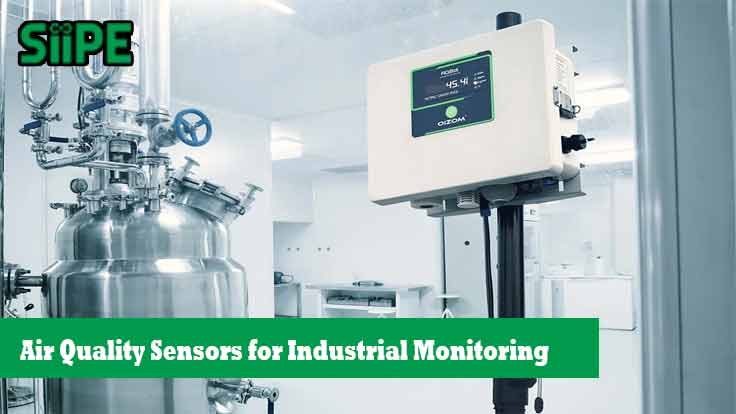In today’s fast-paced industrial landscape, environmental responsibility and worker safety are no longer optional—they are essential. One of the most critical components of modern industrial monitoring is the use of air quality sensors. These devices help detect harmful pollutants, ensure regulatory compliance, and create safer working environments.
But how do air quality sensors work? Why are they crucial for industries? And which types are best suited for different industrial applications?
In this article, we’ll dive deep into the importance of air quality sensors in industrial settings and how they support smarter, safer, and more sustainable operations.
What Are Air Quality Sensors?
Air quality sensors are electronic devices designed to detect and monitor pollutants in the air. These can include gases like CO₂ (carbon dioxide), CO (carbon monoxide), NOx (nitrogen oxides), SO₂ (sulfur dioxide), volatile organic compounds (VOCs), and fine particulate matter such as PM2.5 and PM10.
In industrial settings, these sensors play a vital role in identifying pollutants that may be harmful to humans, machinery, and the environment.
Why Are Air Quality Sensors Important for Industry?
1. Protecting Worker Health
Factories and plants often expose workers to fumes, smoke, and chemicals. Prolonged exposure to poor air quality can lead to respiratory issues, fatigue, and long-term health complications. With real-time air quality monitoring, employers can take action immediately when pollutant levels exceed safe limits.
2. Ensuring Regulatory Compliance
Governments around the world have strict regulations regarding industrial emissions and air quality. Industries must comply with air pollution standards to avoid fines and legal issues. Air quality sensors help companies stay compliant by providing accurate emissions data.
3. Preventing Equipment Damage
Dust and corrosive gases can deteriorate sensitive machinery. By detecting such elements early, companies can schedule maintenance and avoid costly downtime or equipment failure.
4. Improving Sustainability and ESG Performance
Air quality monitoring shows that a company takes its environmental responsibilities seriously. This can improve a firm’s Environmental, Social, and Governance (ESG) score and reputation among investors and customers.
Types of Air Quality Sensors for Industrial Use
Different sensors are suited for different purposes. Here are some of the most commonly used air quality sensors in industrial environments:
1. Particulate Matter Sensors (PM2.5, PM10)
These detect fine dust particles that can penetrate deep into the lungs. Industries such as cement, mining, and textiles benefit greatly from these sensors.
2. Gas Sensors
-
CO and CO₂ Sensors – Useful in steel manufacturing, food processing, and confined factory spaces.
-
NOx and SO₂ Sensors – Important in industries dealing with combustion engines or chemical production.
-
VOC Sensors – Common in paint, solvent, and chemical industries.
3. Multi-Gas Sensors
These are integrated sensors capable of detecting multiple gases simultaneously. Ideal for complex industrial environments where many pollutants are present.
4. Temperature and Humidity Sensors
Though not pollutants, temperature and humidity affect how air pollutants behave. Monitoring these helps industries understand pollutant dispersion and improve indoor air quality strategies.
Where Are Air Quality Sensors Installed?
Air quality sensors are often placed in strategic points throughout a facility:
-
Inside production lines where emissions occur
-
Near exhaust vents to monitor emissions
-
In storage rooms with volatile materials
-
Outside buildings to measure environmental impact
-
On mobile equipment such as forklifts or drones
Real-Time Monitoring and Data Analytics
Modern air quality sensors are part of IoT (Internet of Things) ecosystems. They continuously transmit data to cloud-based platforms where analytics tools process and visualize the information.
Some key features include:
-
Real-time alerts when pollutant thresholds are crossed
-
Historical data trends for audit or improvement
-
Integration with HVAC and ventilation systems for automated response
-
Mobile dashboards accessible from anywhere
This digital transformation allows industries to shift from reactive to proactive air quality management.
Industries That Benefit Most from Air Quality Monitoring
While all industries can benefit, some sectors rely heavily on air quality sensors:
-
Manufacturing – Especially those using solvents, combustion, or heavy machinery
-
Mining and Quarrying – High dust and gas risks
-
Chemical Processing – Monitoring volatile and toxic emissions
-
Food and Beverage – Ensuring clean air to meet hygiene standards
-
Pharmaceuticals – Requires ultra-clean environments
-
Textile and Garment Industry – Fine dust and fiber particles are common pollutants
Challenges in Implementing Air Quality Sensors
Despite their benefits, some challenges still exist:
-
High Initial Costs – Especially for enterprise-level sensor networks
-
Sensor Calibration and Maintenance – Requires regular checks for accuracy
-
Data Overload – Without proper software, large data volumes can be hard to manage
-
Limited Awareness – Some companies still underestimate air quality risks
However, these challenges are rapidly being addressed as technology advances and environmental regulations become stricter.
The Future of Industrial Air Quality Monitoring
As Industry 5.0 emerges, placing humans and sustainability at the center of innovation, air quality sensors will become even more integrated with smart manufacturing systems.
We can expect:
-
AI-powered predictions of pollution events
-
Automated filtration systems triggered by sensor data
-
Integration with smart city infrastructure to manage emissions holistically
-
Wearable air quality sensors for worker safety
Q&A: Air Quality Sensors in Industrial Settings
Q: Can one sensor detect all pollutants?
A: Not usually. Most environments need a combination of sensors (multi-gas, particulate, VOC, etc.) to monitor various threats accurately.
Q: How often should sensors be calibrated?
A: Depending on the environment, every 6–12 months is standard, though some advanced models offer self-calibration features.
Q: Are these sensors useful indoors and outdoors?
A: Yes. Many industrial facilities use both indoor and outdoor monitoring to understand full environmental impact.
Air quality sensors are no longer a luxury—they are a necessity for modern industrial monitoring. From protecting worker health to staying compliant with environmental regulations, these smart devices offer a wide range of benefits.
By integrating real-time monitoring and data-driven analytics, industries can move toward a future that is not only productive and efficient, but also safe and sustainable.
Investing in air quality sensors is an investment in health, innovation, and responsibility—the hallmarks of successful, future-ready industries.










